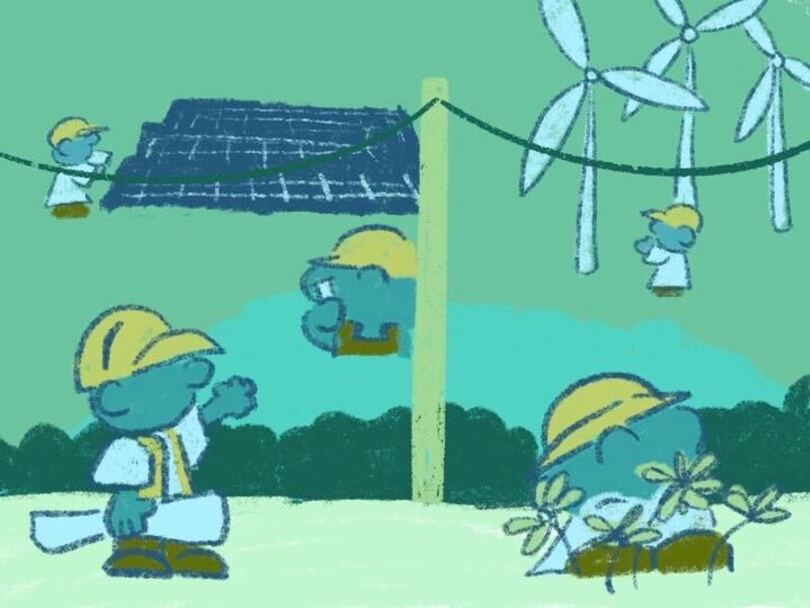‘Green jobs’ provide a new wave of job opportunities for future generations

Emma Lee | Contributing Illustrator
The “green” career field holds promise for those who fear unemployment, says our columnist. There are less limitations for potential employees and is key in fighting climate change.
Get the latest Syracuse news delivered right to your inbox.
Subscribe to our newsletter here.
With the expansion of artificial intelligence and other technologies, 22% of workers fear their jobs will soon be made obsolete. While AI’s advancement is undoubtedly scary, the growth of the “green workforce” presents a unique opportunity for a new job market.
And despite the buzz around the claim that transitioning away from fossil fuels will further limit the supply of available jobs, the International Energy Agency has estimated that the transition will create two to six green jobs for every fossil fuel job lost. The shift from fossil fuel to clean energy is expected to trigger a societal transition that will impact much of the way we live our lives. Legislation, business models, education and consumer behavior will all be influenced by the ripple effects of this grand transition.
And so, the green workforce, or the broad grouping of careers that contribute toward sustainable development and environmental stewardship, is looking for interdisciplinary talent to address the issue of climate change as we shift to renewable energy.
This transition has been referred to as “Industry 5.0,” or the Fifth Industrial Revolution (the previous four also defined by great technological advancements like the start of mechanization, electricity, computers and communication networks). The new industry will “use new technologies to provide prosperity beyond jobs and while respecting the production limits of the planet,” according to a report by the European Union.
It will be an opportunity to holistically approach the topic of energy to create a sustainable solution, with all layers —technical, economic, social and legislative — involved. The aim of Industry 5.0 is not to just become more productive and efficient with a focus on the economy, it is to continue growth sustainably while contributing back to society.
Since the Inflation Reduction Act was signed into law in Aug. 2022, more than 100,000 clean energy jobs have been created across the United States and the World Economic Forum anticipates that green jobs will account for 14% of the U.S. workforce by 2030.

Cole Ross | Digital Design Editor
In Sept. 2023, President Joe Biden launched the American Climate Corps, which intends to put a new generation of Americans to work in environmental positions in sectors such as clean energy, environmental justice, conservation and community resilience. During Biden’s March 2024 State of the Union address, he committed to tripling the number of annual American Climate Corps positions over the next decade.
As students at Syracuse University, we are at the forefront of change in the U.S. as New York state continues to be a leader in climate action. There are over 165,000 clean energy jobs in New York, with over 200,000 more expected over the next decades. Even SU alumna Governor Kathy Hochul has stated her commitment to ensuring New York leads the transition to a clean and green future.
There is plenty of opportunity within the green workforce for all academic disciplines. There is a misconception that to work in the green workforce, one has to be in a specialized role with detailed knowledge of green skills, or technical knowledge and expertise of sustainability initiatives.
However, soft skills are also in high demand in the green workforce, opening the door for those who don’t have specialized training. The ability to critically and analytically think, communicate and solve problems are crucial to success while facing this highly-nuanced issue. “Greening jobs,” or less specialized roles that do not require green skills, are also emerging in a variety of sectors such as healthcare, agriculture, transportation, construction and manufacturing.
There are so many points of entry in responding to climate change, both directly and indirectly. Yes, you can of course help the Earth by going outside and planting trees, but you can also help by advocating for sustainable initiatives.
As you create your academic schedules for next fall and begin to finalize your summer plans, consider taking a class or pursuing an internship in sustainability. You don’t need a green thumb or a multitude of “green skills” to enter the green workforce. There aren’t limitations to who can and can’t help make the world a greener place.
Izzy Kaufman is a sophomore International Relations and Environment, Sustainability and Policy major as well as the Co-Director of the Student Association’s Sustainability Forum. Her column appears bi-weekly. She can be reached at akaufm08@syr.edu.





